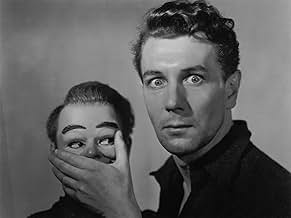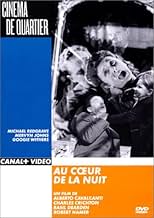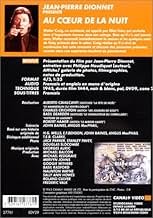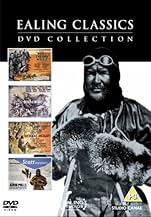ÉVALUATION IMDb
7,5/10
15 k
MA NOTE
Ajouter une intrigue dans votre langueGuests at an English estate recall nightmares.Guests at an English estate recall nightmares.Guests at an English estate recall nightmares.
- Prix
- 2 victoires et 2 nominations au total
Anthony Baird
- Hugh Grainger
- (as Antony Baird)
Esme Percy
- Antique Dealer
- (as Esmé Percy)
Avis en vedette
Anthology n.: a collection of selected literary pieces or passages of works of art or music.
This classic horror-anthology from Britain's Ealing Studios is composed of four separate stories, composed around a group of strangers that is mysteriously gathered at a country estate where each reveals their chilling tale of the supernatural. But even after these frightening tales are told, does one final nightmare await them all?
The horror-anthology has proved a difficult sub-genre, usually made with only limited success, because it's notoriously difficult to get it right. If only one of the stories fails to deliver, the whole piece is dragged down. But this multi-part horror effort from Britain's Ealing Studios still proves to be very effective and justifiably still is one of the most revered and successful horror anthologies ever made. It features appearances by many of the best British actors of it's day, including Mervyn Johns, Ralph Michael, Basil Radford and Michael Redgrave. With four different directors at the helm, not all four segments are equally effective and are quite different in tone, but they are all good in their own right. The standout for me, not judged in terms of the best, but certainly the most frightening story of the four, is "The Ventriloquist Dummy" by Brazilian born Alberto Cavalcanti (he's simply billed as Cavalcanti), the only non-British director involved in DEAD OF NIGHT. Michael Redgrave plays a renowned ventriloquist who descends into an abyss of madness and murder, when his dummy takes on a life of his own. One of the most unsettling stories I've ever seen.
The somewhat less effective (if only slightly) mirror sequence by Robert Hamer shows something very scary can be achieved with very basic means. When Ralph Michael looks in the mirror, to his horror he keeps seeing the reflection of a dark Gothic room lit with candles, completely different from the room he's standing in and slowly, he begins to loose his mind. Ultimately, it is the extremely unsettling music score that makes it work. Basic but very effective.
As with most anthologies, it's difficult to keep track of the main interwoven storyline, because between the different stories we're told, your mind is still very much trying to grasp what you've just seen. This is probably why the genre became increasingly unpopular over the years. With the exception of "The Ventriloquist Dummy", don't expect anything particularly scary, but it did leave me quietly disturbed. The peerless British cast and the witty, slightly old-fashioned tongue-in-cheek dialog makes this very pleasant and appropriately unsettling viewing.
Camera Obscura --- 8/10 --- 10/10 for "The Ventriloquist Dummy"
This classic horror-anthology from Britain's Ealing Studios is composed of four separate stories, composed around a group of strangers that is mysteriously gathered at a country estate where each reveals their chilling tale of the supernatural. But even after these frightening tales are told, does one final nightmare await them all?
The horror-anthology has proved a difficult sub-genre, usually made with only limited success, because it's notoriously difficult to get it right. If only one of the stories fails to deliver, the whole piece is dragged down. But this multi-part horror effort from Britain's Ealing Studios still proves to be very effective and justifiably still is one of the most revered and successful horror anthologies ever made. It features appearances by many of the best British actors of it's day, including Mervyn Johns, Ralph Michael, Basil Radford and Michael Redgrave. With four different directors at the helm, not all four segments are equally effective and are quite different in tone, but they are all good in their own right. The standout for me, not judged in terms of the best, but certainly the most frightening story of the four, is "The Ventriloquist Dummy" by Brazilian born Alberto Cavalcanti (he's simply billed as Cavalcanti), the only non-British director involved in DEAD OF NIGHT. Michael Redgrave plays a renowned ventriloquist who descends into an abyss of madness and murder, when his dummy takes on a life of his own. One of the most unsettling stories I've ever seen.
The somewhat less effective (if only slightly) mirror sequence by Robert Hamer shows something very scary can be achieved with very basic means. When Ralph Michael looks in the mirror, to his horror he keeps seeing the reflection of a dark Gothic room lit with candles, completely different from the room he's standing in and slowly, he begins to loose his mind. Ultimately, it is the extremely unsettling music score that makes it work. Basic but very effective.
As with most anthologies, it's difficult to keep track of the main interwoven storyline, because between the different stories we're told, your mind is still very much trying to grasp what you've just seen. This is probably why the genre became increasingly unpopular over the years. With the exception of "The Ventriloquist Dummy", don't expect anything particularly scary, but it did leave me quietly disturbed. The peerless British cast and the witty, slightly old-fashioned tongue-in-cheek dialog makes this very pleasant and appropriately unsettling viewing.
Camera Obscura --- 8/10 --- 10/10 for "The Ventriloquist Dummy"
Mervyn Johns a quite ordinary architect is summoned for a job by Roland Culver. As he drives up to Culver's house it's in the words of a great 20th century philosopher, deja vu all over again.
Culver's entertaining and Johns comes in and seems to know the people there. When Johns relates what he thinks is happening to him, the others start telling some paranormal tales of their own.
With Mervyn Johns's introductory story unifying the film, Dead Of Night now goes into five very engrossing short stories of some weird experiences that the guests have had. I'm not sure the introductory tale is needed, all five can certainly stand on their own as Gothic drama.
Although all the stories are good, by far the outstanding one involves Michael Redgrave as a ventriloquist whose dummy seems to be taking on a life of its own. One of Culver's guests is psychiatrist Frederick Valk and he contributes this story as he was a consultant on this case. Is it schizophrenia or is that dummy really alive?
I also liked the episode with Sally Ann Howes as a young teenager at a costume party who befriends a young boy whom she sings to sleep with a lullaby. The boy played by Michael Allan had a perfect right to be in that house, but he's a most unwelcome guest at the party.
I might not have even had the linking story included in the film and let the stories stand on their own. But either way Dead Of Night is an engrossing Gothic drama.
Culver's entertaining and Johns comes in and seems to know the people there. When Johns relates what he thinks is happening to him, the others start telling some paranormal tales of their own.
With Mervyn Johns's introductory story unifying the film, Dead Of Night now goes into five very engrossing short stories of some weird experiences that the guests have had. I'm not sure the introductory tale is needed, all five can certainly stand on their own as Gothic drama.
Although all the stories are good, by far the outstanding one involves Michael Redgrave as a ventriloquist whose dummy seems to be taking on a life of its own. One of Culver's guests is psychiatrist Frederick Valk and he contributes this story as he was a consultant on this case. Is it schizophrenia or is that dummy really alive?
I also liked the episode with Sally Ann Howes as a young teenager at a costume party who befriends a young boy whom she sings to sleep with a lullaby. The boy played by Michael Allan had a perfect right to be in that house, but he's a most unwelcome guest at the party.
I might not have even had the linking story included in the film and let the stories stand on their own. But either way Dead Of Night is an engrossing Gothic drama.
I watched this again after a too-long gap of about six years. Were there many anthology films made during this time? "Flesh and Fantasy" (1943) comes to mind but "Dead of Night" is superior. The plot involves an architect who arrives at a country house for work, in a recurring nightmare, and he's terrified because he knows how this nightmare is going to end... At the house there are a number of guests and they soon fall into talking about their own horrifying supernatural tales.
The stories of each of the guests range from semi-comical (the "golfing" episode was my least favorite, although there was one chilling moment even in that one) to the terrifying (the best of the lot, imho, is the 'ventriloquist' episode). Some have speculated that Rod Serling probably drew heavily on "Dead of Night" when writing a number of scripts for "The Twilight Zone" (as just one example, the scene where the dummy bites the hand of the ventriloquist is copied almost exactly in the TZ ep "The Dummy"). I'm not sure if this movie was a blockbuster at the time, but I think it was ahead of its time in terms of depth of concepts, in that there is more than meets the eye.
Dead of Night is one of those movies that actually started a genre. Tame to today's standards many of its short stories can be traced to horror plots today; most notably the ventriloquist dummy come to life (Michael Redgrave sequence). This movie takes horror where it should remain...the suspense film. We can see all the blood and gore today but why do films like The Six Sense (1999) or What Lies Beneath (2000) remain a success? Everyone has their own fears and thoughts of horror; and the thought of that fear and horror adds to the suspense film in all ways more thansay the breed of horror slasher films...probably best portrayed by Psycho, Halloween and the Scream Films. Dead of Night isn't a Hitchcock film but it uses the same actors of his England days and uses the same suspense techniques seen in his tv series. Check this film out and watch it from the perspective of the 1940s viewers eyes and see why it was popular. Also check out Cat People (1942)and M (1931)
I remember being bowled over as a kid when I first saw this classic. I know now that American cinema of the time simply wouldn't risk confusing an audience with such a complex (stunning) wrap-around and a string of separate stories. Then too, that was before humanoid dummies became a horror cliché, and so the effect was doubly jarring. Nonetheless, I'm still astonished at how well Redgrave shades his stages of madness, certainly Oscar worthy in some universe. That episode may be the creepiest and most difficult to figure out in the whole horror genre.
But what really amazes me now is how such a completely collaborative effort could have turned out so well—11 writers, 4 directors, and a large cast of principals. Usually collaborative efforts amount to less than the whole; this one, however, is considerably greater than the whole. After so many comments, there's no need to echo the obvious, except to point out that true horror depends on the psychological and in no way depends on buckets of blood. In my book, the movie's as good now as it was 60-years ago.
But what really amazes me now is how such a completely collaborative effort could have turned out so well—11 writers, 4 directors, and a large cast of principals. Usually collaborative efforts amount to less than the whole; this one, however, is considerably greater than the whole. After so many comments, there's no need to echo the obvious, except to point out that true horror depends on the psychological and in no way depends on buckets of blood. In my book, the movie's as good now as it was 60-years ago.
Le saviez-vous
- AnecdotesThe film's U.S. distributor thought that it was too long; therefore, two of the five segments, "Christmas Party" and "Golfing Story", were both cut. This confused U.S. audiences, who could not understand at all what Michael Allen from "Christmas Party" was doing in the nightmare montage at the end of it. The two segments have since been restored to all U.S. releases of the film.
- GaffesAs Peter Cortland stands looking into the mirror his wife-to-be has bought him, the stripes on his tie run from his left side down to his right. A reverse shot shows the stripes on his tie running in the same direction; obviously, this is not a mirror image.
- Citations
Hearse Driver: Just room for one inside, sir.
- Autres versionsThe original UK version of this film was 105 minutes long and had five segments in it ("Hearse Driver", "Christmas Party", "Haunted Mirror", "Golfing Story" and "Ventriloquist's Dummy"). When it was originally released in the U.S., two of the five segments ("Christmas Party" and "Golfing Story") were cut to shorten it to 77 minutes because the distributor though that it was too long. Later re-releases of it in the U.S., such as the TV version and all of its home video releases, restored the two missing segments to their proper places in it.
- ConnexionsEdited into Pirates (1995)
- Bandes originalesThe Hullalooba
Music by Anna Marly
Lyrics by Anna Marly
Sung by Elisabeth Welch with Frank Weir and his Sextet
Meilleurs choix
Connectez-vous pour évaluer et surveiller les recommandations personnalisées
- How long is Dead of Night?Propulsé par Alexa
Détails
Box-office
- Brut – à l'échelle mondiale
- 35 275 $ US
- Durée1 heure 43 minutes
- Couleur
- Rapport de forme
- 1.37 : 1
Contribuer à cette page
Suggérer une modification ou ajouter du contenu manquant


























